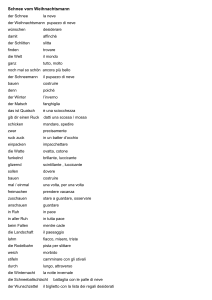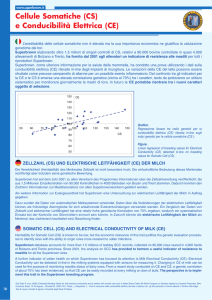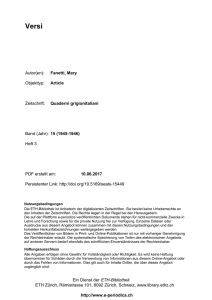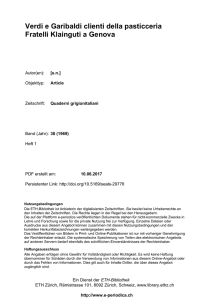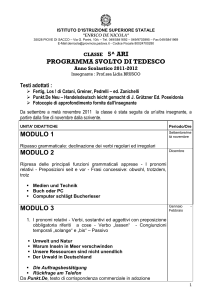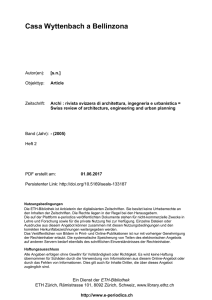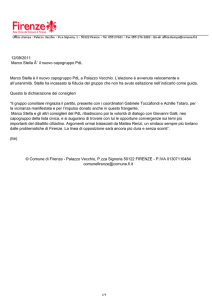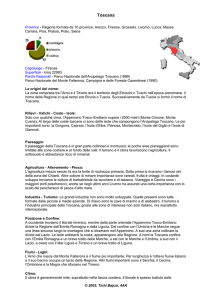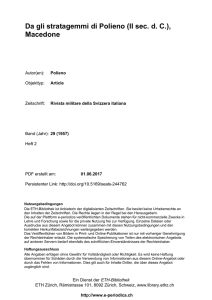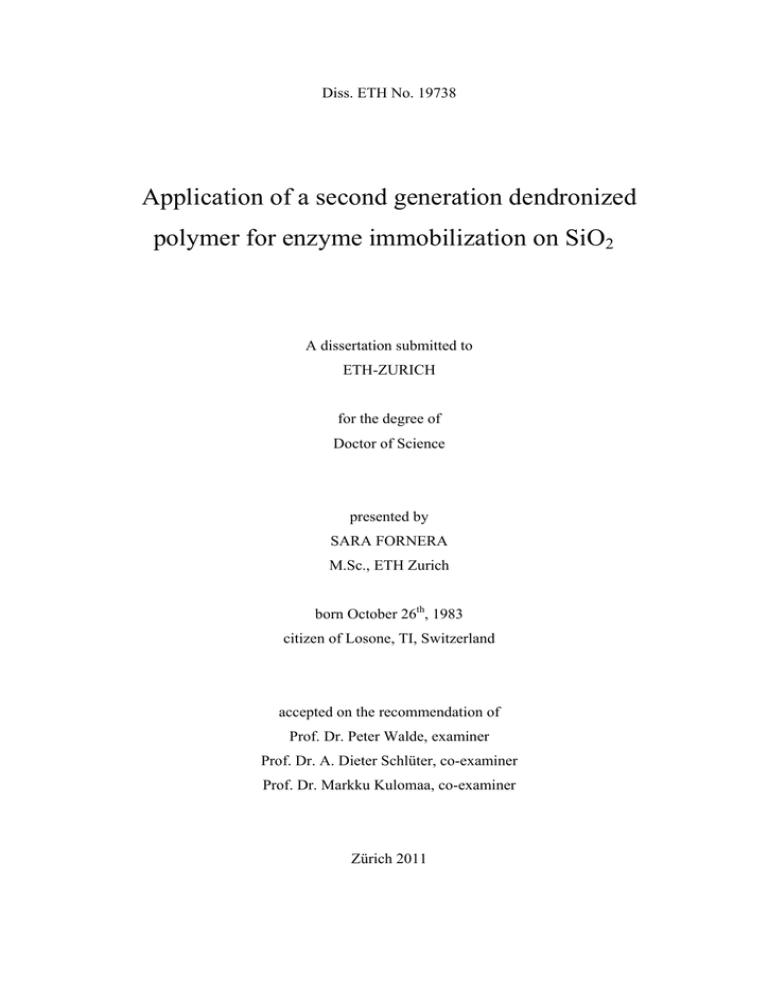
Diss. ETH No. 19738
Application of a second generation dendronized
polymer for enzyme immobilization on SiO2
A dissertation submitted to
ETH-ZURICH
for the degree of
Doctor of Science
presented by
SARA FORNERA
M.Sc., ETH Zurich
born October 26th, 1983
citizen of Losone, TI, Switzerland
accepted on the recommendation of
Prof. Dr. Peter Walde, examiner
Prof. Dr. A. Dieter Schlüter, co-examiner
Prof. Dr. Markku Kulomaa, co-examiner
Zürich 2011
Abstract
An enzymatic cascade reaction is a series of consecutive enzymatic reactions that
are performed without product recovery after each step. Enzymatic cascade reactions
currently are of great interest for their applications in the regio- and enantioselective
synthesis of molecules under mild reaction conditions and for the quantification of
analytes. If the enzymes taking part in the reaction are immobilized on a substrate, the
easy separation of the enzymes from the reaction solution along with the possible
reuse of the enzymes considerably decrease the costs of the process.
In this thesis, a second generation water soluble dendronized polymer (de-PG2) was
investigated for its potential use as soft organic layer for the immobilization of
enzymes on glass. The linker chosen for binding the enzymes to de-PG2 was the noncovalent biotin/avidin system. The enzymes selected for this work were βgalactosidase (β-Gal), glucose oxidase (GOD), and horseradish peroxidase (HRP),
because they allow the quantification of lactose via an enzymatic cascade reaction.
First, β-Gal catalyzes the hydrolysis of lactose into D-glucose and D-galactose. Then
D-glucose is oxidized into H2O2 and glucono-δ-lactone by GOD; and eventually the
quantification of H2O2 is possible via the oxidation of ortho-phenylenediamine (OPD)
by HRP.
Initially, the possible advantages of using de-PG2 versus the conventional polymer
α-D-polylysine (PDL) for enzyme immobilization on glass were investigated. The
reactivity of the amino groups at the periphery of de-PG2 regarding biotinylation was
found to be comparable to the reactivity of the ε-amino groups of PDL. The
adsorption behaviour of de-PG2 and PDL on SiO2 was studied with the Transmission
Interferometric Adsorption Sensor (TInAS). The adsorption behaviour of de-PG2 was
found to be more reproducible as compared to PDL. Moreover, the de-PG2 adsorbed
layer was more resistant to acidic desorption than the PDL adsorbed layer. These two
observations could be a consequence of the fact that de-PG2 has four amino groups
per repeating unit while PDL has only one. This renders the backbone of de-PG2
more rigid and the polymer more positively charged than PDL. These two features
V
could favour the more stable and neater adsorption on the glass surface in the case of
de-PG2 as compared to PDL.
In the beginning of the enzyme immobilization, either biotinylated de-PG2 or
biotinylated PDL were adsorbed on glass in the TInAS flow cell. Avidin was
specifically adsorbed on the layer composed of the biotinylated polymer. Afterwards,
biotinylated HRP was adsorbed on the polymer/avidin layer. The TInAS studies
showed that de-PG2 clearly immobilized a larger amount of HRP than PDL.
Therefore, the adsorption of GOD and β-Gal was studied in the TInAS flow cell with
de-PG2 as soft organic layer only. The adsorption conditions that minimized the
unspecific enzyme adsorption on the de-PG2/avidin layer were optimized. Under
appropriate adsorption conditions, the unspecific adsorption of HRP and GOD could
be avoided. In case of β-Gal, a maximum of 8% unspecific adsorption was reached.
Eventually, it was proven, via in situ TInAS activity measurements, that the
immobilized enzymes retained their capability of catalyzing one step of the cascade
reaction necessary for lactose quantification.
In the last part of the project, the cascade reaction involving all three enzymes was
analyzed. First, the enzymatic cascade reaction for the one-pot quantification of
lactose via β-Gal/GOD/HRP was optimized with all the enzymes dissolved in solution.
Then, using the protocol for enzyme immobilization on glass established with the
TInAS, the enzymes were immobilized on commercially available glass slides. Also
in this case, de-PG2 was found to be better than PDL as soft organic layer. When
HRP was immobilized with de-PG2/avidin on glass, HRP retained twice the activity
as compared to HRP immobilized with PDL/avidin after four weeks storage in
phosphate buffer. Afterwards, the three enzymes were immobilized inside three glass
tubes with the help of the de-PG2/avidin layer. When the tubes were connected in the
β-Gal/GOD/HRP sequence, lactose could be quantified, using OPD as chromogenic
substrate for HRP.
As last application of this cascade reaction system, β-Gal, GOD, and HRP were
immobilized sequentially with the help of de-PG2/avidin inside a microfluidic reactor
(glass/polydimethylsiloxane). The quantification of lactose was possible also in this
case. The stability of the system during storage was studied and found to be promising
for future applications in which the stable immobilization of different types of
enzymes is required.
VI
The presented successful immobilization approach is expected to be generally
applicable for any synthetic and analytical reaction in which multiple enzymatic steps
are required.
Furthermore, preliminary results showed that the formation of the de-PG2/enzyme
conjugate via the avidin/biotin system is possible in solution, as demonstrated with
HRP as model enzyme. After conjugation with de-PG2 in solution, HRP remained
active.
VII
Riassunto
Nei processi di catalisi enzimatica, l’immobilizzazione di enzimi su substrati è un
aspetto di fondamentale importanza per applicazioni industriali in quanto il recupero e
riutilizzo del catalizzatore comporta minori costi d’esercizio.
A questo scopo, nell’ambito di questa tesi di dottorato, è stato studiato l’uso del
polimero dendronizzato de-PG2 come strato organico per l’immobilizzazione di
enzimi sul vetro. α-D-polilisina (PDL) è stata utilizzata per un confronto come strato
organico di riferimento. Al fine di verificare che il processo d’immobilizzazione non
influenzi negativamente l’attività catalitica dell’enzima, la reazione a cascata
enzimatica utilizzata per la quantificazione del lattosio è stata presa in considerazione.
Gli enzimi coinvolti in questa reazione sono la β-galattosidasi (β-Gal), che catalizza
l’idrolisi del lattosio a D-glucosio e D-galattosio, la glucosio ossidasi (GOD), che
catalizza l’ossidazione di β-D-glucosio in gluco-δ-lactone e H2O2, e la perossidasi del
radicchio (HRP), che nell’ultimo step reattivo quantifica la concentrazione di H2O2
prodotta attraverso l’ossidazione dell’orto-difenildiammina (OPD).
In una prima fase del lavoro, sono stati investigati i possibili vantaggi dell’utilizzo
del polimero dendronizzato de-PG2 rispetto alla PDL come strato organico per
immobilizzare gli enzimi sul vetro. Durante il processo di biotinilizzazione la
reattività dei gruppi aminici dei due polimeri (de-PG2 e PDL) è risultata simile.
L’adsorbimento al vetro dei due polimeri è stato monitorato con il sensore
d’adsorbimento
Transmission
Interferometric
Adsorption
Sensor
TInAS.
L’adsorbimento del de-PG2 si è dimostrato più riproducibile di quello della PDL.
Inoltre lo strato formato dal de-PG2 è risultato più resistente rispetto al desorbimento
dovuto all’effetto di soluzioni acide. Entrambi questi risultati potrebbero essere una
conseguenza del fatto che l’unità ripetitiva del de-PG2 è più voluminosa di quella
della PDL e presenta quattro gruppi aminici alla periferia. Ne consegue che la catena
del de-PG2 è più rigida di quella della PDL e che il de-PG2 presenta una maggiore
carica positiva della PDL.
Il protocollo per l’immobilizzazione degli enzimi sul vetro prevedeva tre fasi
successive d’adsorbimento: (i) il polimero biotinilato è stato adsorbito sul vetro, (ii)
l’avidina è stata adsorbita sullo strato di polimero, e (iii) l’enzima biotinilato è stato
VIII
coniugato all’avidina. Al fine di valutare l’influenza dello strato organico nel processo
d’immobilizzazione, HRP è stata immobilizzata sia con de-PG2 che con PDL. Lo
studio con il TInAS ha mostrato che de-PG2 è più efficiente nell’immobilizzare
l’HRP rispetto alla PDL. Inoltre, l’analisi dell’attività enzimatica dell’HRP durante lo
stoccaggio in soluzione tampone ha rivelato una maggiore stabilità dell’HRP quando è
stata immobilizzata sul vetro con lo strato de-PG2/vetro.
Le condizioni durante l’adsorbimento monitorato con il TInAS sono state variate per
adsorbite HRP e GOD unicamente in modo specifico. Nel caso della β-Gal, è stato
misurato un massimo di 8% d’adsorbimento non specifico. Mediante misure di attività
condotte in situ, è stato dimostrato che tutti e tre gli enzimi immobilizzati conservano
l’attività catalitica.
Nell’ultima parte del progetto, la reazione a cascata alla quale prendono parte tutti e
tre gli enzimi è stata analizzata. In primo luogo la reazione a cascata enzimatica per la
quantificazione del lattosio via β-Gal/GOD/HRP è stata ottimizzata quando tutti e tre
gli enzimi erano in soluzione. In seguito il protocollo per l’immobilizzazione degli
enzimi messo a punto con il TInAS è stato applicato per immobilizzare i diversi
enzimi con lo strato de-PG2/avidina all’interno di tre differenti tubi di vetro. Come
previsto, unicamente collegando i tubi con immobilizzati gli enzimi nella sequenza βGal/GOD/HRP la concentrazione del lattosio in soluzione era quantificabile.
Gli enzimi β-Gal, GOD e HRP sono anche stati immobilizzati in sequenza
all’interno di un unico microchip (vetro/polidimetilsilossano). Anche in questo caso la
quantificazione del lattosio è stata possibile. Questa scoperta apre le porte a nuove
possibili applicazioni del sistema presentato nelle quali diversi enzimi vengono
immobilizzati in sequenza all’interno dello stesso microchip per quantificare diverse
sostanze o per sintetizzare una molecola con una reazione a cascata enzimatica.
Inoltre, usando HRP come enzima modello, è stato dimostrato che il coniugato dePG2/enzima può essere formato anche direttamente in soluzione usando il sistema
biotina/avidina. Dopo la coniugazione, l’enzima è ancora attivo.
IX
Zusammenfassung
Eine Kaskadenreaktion ist eine Reihe aufeinanderfolgender enzymatischer
Reaktionen, die ohne Produktrückgewinnung zwischen den einzelnen Schritten
durchgeführt wird. Enzymatische Kaskadenreaktionen sind zur Zeit von grossem
Interesse aufgrund ihrer Anwendungen in der regio- und enantioselektiven
Molekülsynthese unter milden Reaktionsbedingungen und zur Quantifizierung von
Analyten. Wenn die an einer Reaktion teilnehmenden Enzyme auf einem Substrat
immobilisiert werden, verringert die einfache Trennung der Enzyme von der
Reaktionslösung und daraus folgend die mögliche Wiederverwendung der Enzyme
die Kosten des Prozesses signifikant.
In dieser Arbeit wurde ein wasserlösliches, dendronisiertes Polymer zweiter
Generation (de-PG2) auf sein Potential hin untersucht, als weiche organische Schicht
zur Enzymimmobilisierung auf Glas genutzt zu werden. Die Enzyme wurden durch
das nicht-kovalente Biotin/Avidin-System an de-PG2 gekoppelt. Die Enzyme βGalaktosidase (β-Gal), Glukose-Oxidase (GOD) und Meerrettichperoxidase (HRP)
wurden für diese Arbeit ausgewählt, da sie die Quantifizierung von Laktose über eine
enzymatische Kaskadenreaktion ermöglichen. Zunächst katalysiert β-Gal die
Hydrolyse von Laktose zu D-Glukose und D-Galactose. Dann wird D-Glukose durch
GOD zu H2O2 und Glucono-1,5-lacton oxidiert; und schliesslich ist die
Quantifizierung von H2O2 durch die Oxidation von ortho-Phenylendiamin (OPD)
durch HRP möglich.
Im ersten Teil der Arbeit wurden die möglichen Vorteile der Nutzung von de-PG2
anstelle des konventionellen α-D-Polylysin (PDL) zur Enzymimmobilisierung auf
Glas untersucht. Die Reaktivität der Aminogruppen an der Peripherie von de-PG2
bezüglich der Biotinylierung ist vergleichbar mit der Reaktivität der ε-Aminogruppen
von PDL. Das Adsorptionsverhalten von de-PG2 und PDL SiO2 wurde mit dem
Transmission
Interferometric
Adsorption
Sensor
(TInAS)
untersucht.
Das
Adsorptionsverhalten von de-PG2 war dabei besser reproduzierbar als jenes von PDL.
Ausserdem war die adsorbierte de-PG2-Schicht resistenter gegenüber saurer
Desorption als die PDL-Schicht. Diese zwei Beobachtungen könnten eine direkte
X
Folge
der
Tatsache
sein,
dass
de-PG2
über
vier
Aminogruppen
pro
Wiederholungseinheit verfügt und PDL nur über eine. Dies macht den Hauptstrang
von de-PG2 steifer und das Polymer wird stärker positiv geladen als PDL. Diese
Eigenschaften begünstigen eine stabilere und sauberere Adsorption auf der
Glasoberfläche im Fall von de-PG2 verglichen mit PDL.
Zu Beginn der Enzymimmobilisierung wurden entweder biotinyliertes de-PG2 oder
biotinyliertes PDL in der TInAS-Flusszelle auf Glas adsorbiert. Avidin wurde dann
auf der biotinylierten Polymerschicht adsorbiert. Danach wurde biotinyliertes HRP
auf der Polymer/Avidin-Schicht adsorbiert. Die TInAS-Messungen zeigten, dass dePG2 eine deutlich grössere Menge HRP immobilisierte als PDL. Daher wurde die
Adsorption von GOD und β-Gal in der TInAS-Flusszelle nur mit de-PG2 als weicher
organischer Schicht untersucht. Die Adsorptionsbedingungen wurden auf eine
minimale unspezifische Enzymadsorption auf der de-PG2/Avidin-Schicht optimiert.
Unter geeigneten Adsorptionsbedingungen konnte die unspezifische Adsorption von
HRP und GOD gänzlich vermieden werden. Im Fall von β-Gal wurde ein Maximum
von 8% unspezifischer Adsorption erreicht. Letztendlich konnte mittels in situ TInASAktivitätsmessungen bewiesen werden, dass die immobilisierten Enzyme ihre
Fähigkeit behielten, einen Schritt der Kaskadenreaktion zu katalysieren, der für die
Laktosequantifizierung notwendig ist.
Im letzten Teil des Projekts wurde die Kaskadenreaktion mit allen drei Enzymen
analysiert. Zunächst wurde die enzymatische Kaskadenreaktion für die „one pot“Quantifizierung von Laktose mit β-Gal/GOD/HRP optimiert, wobei alle Enzyme
gelöst vorlagen. Daraufhin wurden die Enzyme auf kommerziell erhältlichen
Glassscheiben
immobilisiert,
wobei
das
zuvor
erarbeitete
Protokoll
zur
Enzymimmobilisierung auf Glas mit TInAS genutzt wurde. Auch hier stellte sich dePG2 als weiche, organische Schicht wieder als besser geeignet als PDL heraus. Im
Fall von immobilisiertem HRP mit de-PG2/Avidin auf Glas, hatte HRP nach
vierwöchiger Lagerung in einer Phosphatlösung die doppelte Aktivität verglichen mit
jener von HRP auf PDL/Avidin. Danach wurden die drei Enzyme mithilfe der dePG2/Avidin-Schicht in drei Glasröhrchen immobilisiert. Wenn die Röhrchen in der
Sequenz β-Gal/GOD/HRP verknüpft wurden, konnte Laktose unter Nutzung von
OPD als chromogenem Substrat für HRP quantifiziert werden.
XI
Als letzte Anwendung dieses Kaskadenreaktions-Systems wurden β-Gal, GOD und
HRP nacheinander mithilfe der de-PG2/Avidin-Schicht in Glas-PolydimethylsiloxanMikrokanälen immobilisiert. Die Quantifizierung von Laktose war auch in diesem
Fall möglich. Die Stabilität des Systems während Lagerung wurde untersucht und ist
vielversprechend für zukünftige Anwendungen, die eine stabile Immobilisierung
verschiedener Enzymtypen erfordern.
Der vorgestellte, erfolgreiche Ansatz der Immobilisierung ist voraussichtlich auf
prinzipiell jede synthetische und analytische Reaktion anwendbar, die mehrere
enzymatische Schritte benötigt.
Zudem zeigen vorläufige Ergebnisse, dass die Bildung der de-PG2/EnzymKonjugate mit dem Avidin/Biotin-System in Lösung möglich ist, wie mit HRP als
Modellenzym gezeigt werden konnte. Nach der Konjugation mit de-PG2 in Lösung
bleibt HRP aktiv.
XII


